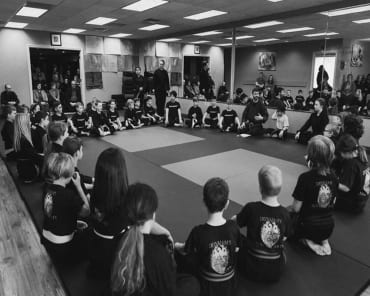In kenpo, we teach the Five Prerequisites of Proper Performance.
- Continuity
- Angles
- Balance
- Liveliness
- Posture
Two of those prerequisites, Balance and Posture, relate specifically to stance and the way it affects your effectiveness in combat. Nakayama Masatoshi, the renowned karate Master, disciple of Master Funakoshi, and contemporary of respected martial arts historian Donn Draeger discusses the importance of Stance and Posture in his 1986 instructional text, Dynamic Karate.
Page 23
"IMPORTANCE OF CORRECT FORM
If the body lacks balance and stability, offensive and defensive techniques will be ineffective. The ability to defend against an attack under any circumstances depends largely upon the maintenance of correct form.
Stance in karate is mainly concerned with the position of the lower part of the body. Powerful, fast, accurate, and smoothly executed techniques can be performed only from a strong and stable base. The upper body must be firmly settled on this strong base, and the back kept straight, or perpendicular to the ground. Although an effective attack is impossible without a strong stance, it is only necessary to assume this position just before delivering an attack. If the student concentrates too much on remaining in a firm and stable position, he will lose mobility.
REQUIREMENTS OF A GOOD STANCE
In addition to the above, the following points are closely related to the development of a good stance. The student must:
A. Be well balanced when applying offensive or defensive techniques;
B. Rotate his hips smoothly when executing techniques;
C. Apply his techniques with the greatest possible speed; and
D. Insure that his muscles used in attack or defense work together harmoniously.
Therefore, the first consideration is the establishment of a strong and stable base. From this base all parts of the body must work together harmoniously as a single unit. In other words, the feet, legs, trunk, arms, and hands must be well controlled individually, but at the same time work together as a unit.
It is important also that the muscles necessary to perform a particular technique respond fully, and that those not used be kept relaxed. If your stance is incorrect, the harmonious interaction of your muscles will be absent and your techniques less effective. Poor form brings unnecessary muscles into play, muscles which often hamper speedy and powerful movements. Strong, fast techniques depend for their execution upon a firm base. Further, the delicate control necessary in karate is only possible with a stable and correct stance.
Most karate students have only an incomplete knowledge of stance. Many are unfamiliar with the varieties possible. Even in the case of a particular stance, there is a real difference in its form at various times. For example, the form of a particular stance is different in the ready position from its form at the time a technique is applied. The form of the stance immediately after the technique has been applied again different from the preceding two. There is a delicate change at each stage, although the form looks almost the same.
The concept of one definite stance for a particular occasion is foreign to karate. The stance chosen varies according to the circumstances. however, it must be natural and it must allow one to move freely in all directions and to assume any position.
A few concrete examples can help illustrate the above points. In zenkutsu-dachi (front stance), there is an important difference between the stance as a preparation for applying a technique and the same stance at the moment of application. In the former instance the knee of the front leg must be bent and the muscles in the thighs and calves of both legs relaxed to permit flexible and quick movement. However, the instant a technique is applied, the muscles of the legs must tense to strengthen the hold of the feet on the ground and to give power to the movement.
Furthermore, in either the front stance or neko-ashi-dachi (cat stance), the position taken must not be so low that the muscles become tense, inflexible, or stiff. If this occurs it will be impossible to move quickly when necessary.
It is detrimental to the development of beginners if, instead of concentrating on basic training, they attempt to imitate the stance used by advanced students. The advanced may stand very lightly with their hips in a relatively high position. however, they can change this stance in an instant to a very strong and firm on with the hips low. It is difficult for beginners to duplicate this change, for the obvious reason that advanced students have spent a much longer time practicing. If beginners stand like the advanced, they will lose their balance at the moment of focusing the technique. Remember that in addition to stability while in a ready, or defensive, position, the stance must provide enough strength and firmness to withstand the shock caused by the application of techniques.
Stance changes according to the direction of our movement and the kind of techniques applied. The exhaustive studies of our predecessors have resulted in a number of stances which form the basis of present-day karate.
Each stance was designed for a particular purpose. Therefore, progress in learning will be slow if beginners do not adhere strictly to the form of each stance. Do not permit the form of a particular stance to deteriorate so that it is difficult to tell it from another. Pay strict attention to the requirements of each stance.
Certain training methods are useful in learning a stance. For example, it is helpful to keep the same stance under tension for a long time. Another method is to alternately tense and relax the muscles for short intervals while holding the stance. This latter method also helps to develop the coordination and to cultivate the feeling necessary for correctly focusing a technique.
When learning a stance it is helpful to practice the offensive and defensive techniques which are the best delivered from it."
Practice your stances. Too often, we focus on blocks and kicks and punches and self defense techniques and combinations and forget to practice our stances. Practice them in place. Practice them in motion. Practice them on uneven terrain.
Practice your stances. Work on Balance and Posture. Practice practice practice. Stance is everything. Stance comes first. Mastering your stances is the beginning of mastering karate.






